Yamaha YPT-270, PSR-E273 Users Manual
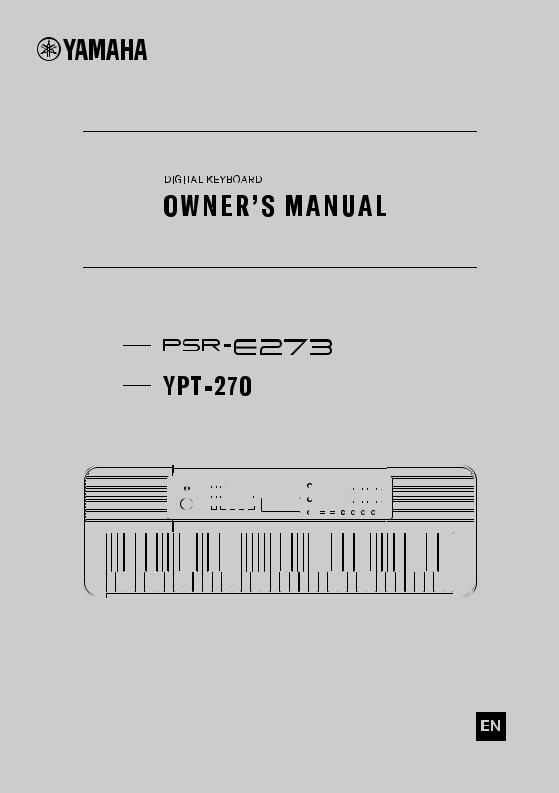
Before using the instrument, be sure to read “PRECAUTIONS” on pages 5–7.
PSR-E273 YPT-270 Owner’s Manual 1
2 PSR-E273 YPT-270 Owner’s Manual

|
FCC INFORMATION (U.S.A.) |
|
1. |
IMPORTANT NOTICE: DO NOT MODIFY THIS UNIT! |
tronic devices. Compliance with FCC regulations does not |
|
This product, when installed as indicated in the instructions |
guarantee that interference will not occur in all installations. If |
|
contained in this manual, meets FCC requirements. Modifica- |
this product is found to be the source of interference, which |
|
tions not expressly approved by Yamaha may void your |
can be determined by turning the unit “OFF” and “ON”, please |
|
authority, granted by the FCC, to use the product. |
try to eliminate the problem by using one of the following mea- |
2. |
IMPORTANT: When connecting this product to accesso- |
sures: |
Relocate either this product or the device that is being |
||
|
ries and/or another product use only high quality shielded |
affected by the interference. |
|
cables. Cable/s supplied with this product MUST be used. |
Utilize power outlets that are on different branch (circuit |
|
Follow all installation instructions. Failure to follow instructions |
breaker or fuse) circuits or install AC line filter/s. |
|
could void your FCC authorization to use this product in the |
In the case of radio or TV interference, relocate/reorient the |
|
USA. |
antenna. If the antenna lead-in is 300 ohm ribbon lead, |
3. NOTE: This product has been tested and found to comply |
change the lead-in to co-axial type cable. |
|
If these corrective measures do not produce satisfactory |
||
|
with the requirements listed in FCC Regulations, Part 15 for |
results, please contact the local retailer authorized to distrib- |
|
Class “B” digital devices. Compliance with these requirements |
ute this type of product. If you can not locate the appropriate |
|
provides a reasonable level of assurance that your use of this |
retailer, please contact Yamaha Corporation of America, Elec- |
|
product in a residential environment will not result in harmful |
tronic Service Division, 6600 Orangethorpe Ave, Buena Park, |
|
interference with other electronic devices. This equipment |
CA90620 |
|
generates/uses radio frequencies and, if not installed and |
The above statements apply ONLY to those products distrib- |
|
used according to the instructions found in the users manual, |
uted by Yamaha Corporation of America or its subsidiaries. |
|
may cause interference harmful to the operation of other elec- |
|
|
|
|
* This applies only to products distributed by Yamaha Corporation of America. |
(class B) |
|
COMPLIANCE INFORMATION STATEMENT (Supplier’s declaration of conformity procedure)
Responsible Party : Yamaha Corporation of America
Address : 6600 Orangethorpe Ave., Buena Park, Calif. 90620
Telephone : 714-522-9011
Type of Equipment : Digital Keyboard
Model Name : PSR-E273/YPT-270
This device complies with Part 15 of the FCC Rules.
Operation is subject to the following two conditions:
1)this device may not cause harmful interference, and
2)this device must accept any interference received including interference that may cause undesired operation.
* This applies only to products distributed by Yamaha Corporation of America. |
(FCC SDoC) |
PSR-E273 YPT-270 Owner’s Manual 3
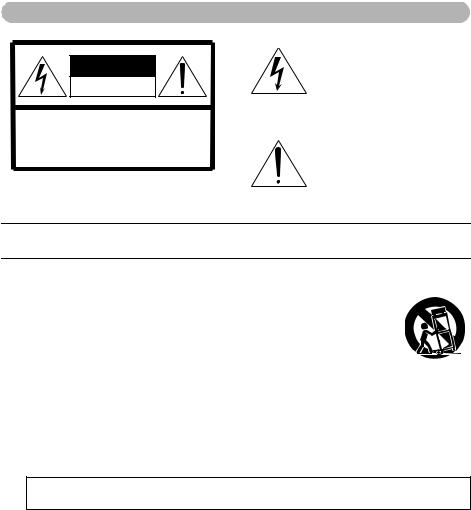
For AC adaptor
CAUTION
RISK OF ELECTRIC SHOCK
DO NOT OPEN
CAUTION: TO REDUCE THE RISK OF ELECTRIC SHOCK, DO NOT REMOVE COVER (OR BACK). NO USER-SERVICEABLE PARTS INSIDE. REFER SERVICING TO QUALIFIED SERVICE PERSONNEL.
Explanation of Graphical Symbols
The lightning flash with arrowhead symbol within an equilateral triangle is intended to alert the user to the presence of uninsulated “dangerous voltage” within the product’s enclosure that may be of sufficient magnitude to constitute a risk of electric shock to persons.
The exclamation point within an equilateral triangle is intended to alert the user to the presence of important operating and maintenance (servicing) instructions in the literature accompanying the product.
IMPORTANT SAFETY INSTRUCTIONS
1 Read these instructions.
2 Keep these instructions.
3Heed all warnings.
4Follow all instructions.
5 Do not use this apparatus near water.
6Clean only with dry cloth.
7Do not block any ventilation openings. Install in accordance with the manufacturer’s instructions.
8Do not install near any heat sources such as radiators, heat registers, stoves, or other apparatus (including
amplifiers) that produce heat.
9Do not defeat the safety purpose of the polarized or grounding-type plug. A polarized plug has two blades with one wider than the other. A grounding type plug has two blades and a third grounding prong. The wide blade or the third prong are provided for your safety. If
the provided plug does not fit into your outlet, consult an electrician for replacement of the obsolete outlet.
10Protect the power cord from being walked on or pinched particularly at plugs, convenience receptacles, and the point where they exit from the apparatus.
11Only use attachments/accessories specified by the manufacturer.
12Use only with the cart, stand, tripod, bracket, or table specified
by the manufacturer, or sold with the apparatus. When a cart is used, use caution when moving the cart/apparatus combination to avoid injury from tip-over.
13Unplug this apparatus during
lightning storms or when unused for long periods of time.
14Refer all servicing to qualified service personnel. Servicing is required when the apparatus has been damaged in any way, such as power-supply cord or plug is damaged, liquid has been spilled or objects have fallen into the apparatus, the apparatus has been exposed to rain or moisture, does not operate normally, or has been dropped.
WARNING
TO REDUCE THE RISK OF FIRE OR ELECTRIC SHOCK, DO NOT EXPOSE THIS APPARATUS TO RAIN OR MOISTURE.
(UL60065_03)
4 PSR-E273 YPT-270 Owner’s Manual

PRECAUTIONS
PLEASE READ CAREFULLY BEFORE PROCEEDING
Please keep this manual in a safe and handy place for future reference.
For the AC adaptor
 WARNING
WARNING
•This AC adaptor is designed for use with only Yamaha electronic instruments. Do not use for any other purpose.
•Indoor use only. Do not use in any wet environments.
 CAUTION
CAUTION
•When setting up, make sure that the AC outlet is easily accessible. If some trouble or malfunction occurs, immediately turn off the power switch of the instrument and disconnect the AC adaptor from the outlet. When the AC adaptor is connected to the AC outlet, keep in mind that electricity is flowing at the minimum level, even if the power switch is turned off. When you are not using the instrument for a long time, make sure to unplug the power cord from the wall AC outlet.
For this instrument
 WARNING
WARNING
Always follow the basic precautions listed below to avoid the possibility of serious injury or even death from electrical shock, short-circuiting, damages, fire or other hazards. These precautions include, but are not limited to, the following:
Power supply/AC adaptor |
|
Water warning |
•Do not place the power cord near heat sources such as heaters or radiators. Also, do not excessively bend or otherwise damage the cord, or place heavy objects on it.
•Only use the voltage specified as correct for the instrument. The required voltage is printed on the name plate of the instrument.
•Use the specified adaptor (page 24) only. Using the wrong adaptor can result in damage to the instrument or overheating.
•Check the electric plug periodically and remove any dirt or dust which may have accumulated on it.
•Do not expose the instrument to rain, use it near water or in damp or wet conditions, or place on it any containers (such as vases, bottles or glasses) containing liquids which might spill into any openings. If any liquid such as water seeps into the instrument, turn off the power immediately and unplug the power cord from the AC outlet. Then have the instrument inspected by qualified Yamaha service personnel.
•Never insert or remove an electric plug with wet hands.
|
|
|
|
|
|
|
|
|
|
|
Fire warning |
||
|
|
|
|
|
|
|
|
Do not open |
• Do not put burning items, such as candles, on the unit. A burning |
||||
• This instrument contains no user-serviceable parts. Do not open |
|
item may fall over and cause a fire. |
||||
|
|
|
|
|||
|
the instrument or attempt to disassemble or modify the internal |
|
|
|
|
|
|
components in any way. If it should appear to be malfunctioning, |
|
|
|
||
|
|
Battery |
||||
|
discontinue use immediately and have it inspected by qualified |
• Follow the precautions below. Failure to do so might result in |
||||
|
Yamaha service personnel. |
|||||
|
|
|
|
explosion, fire, overheating or battery fluid leakage. |
||
|
|
|
- |
Do not tamper with or disassemble batteries. |
||
|
|
|
- |
Do not dispose of batteries in fire. |
||
DMI-7 1/3
PSR-E273 YPT-270 Owner’s Manual 5

-Do not attempt to recharge batteries that are not designed to be charged.
-Keep the batteries separate from metallic objects such as necklaces, hairpins, coins, and keys.
-Use the specified battery type (page 24) only.
-Use new batteries, all of which are the same type, same model, and made by the same manufacturer.
-Always make sure all batteries are inserted in conformity with the +/- polarity markings.
-When the batteries run out, or if the instrument is not to be used for a long time, remove the batteries from the instrument.
-When using Ni-MH batteries, follow the instructions that came with the batteries. Use only the specified charger device when charging.
•Keep batteries away from small children who might accidentally swallow them.
•If the batteries do leak, avoid contact with the leaked fluid. If the battery fluid should come in contact with your eyes, mouth, or skin, wash immediately with water and consult a doctor. Battery fluid is corrosive and may possibly cause loss of sight or chemical burns.
If you notice any abnormality
•When one of the following problems occur, immediately turn off the power switch and disconnect the electric plug from the outlet. (If you are using batteries, remove all batteries from the instrument.) Then have the device inspected by Yamaha service personnel.
-The power cord or plug becomes frayed or damaged.
-It emits unusual smells or smoke.
-Some object has been dropped into the instrument.
-There is a sudden loss of sound during use of the instrument.
-If any cracks or breakages exist on the instrument.
 CAUTION
CAUTION
Always follow the basic precautions listed below to avoid the possibility of physical injury to you or others, or damage to the instrument or other property. These precautions include, but are not limited to, the following:
Power supply/AC adaptor
•Do not connect the instrument to an electrical outlet using a multiple-connector. Doing so can result in lower sound quality, or possibly cause overheating in the outlet.
•When removing the electric plug from the instrument or an outlet, always hold the plug itself and not the cord. Pulling by the cord can damage it.
•Remove the electric plug from the outlet when the instrument is not to be used for extended periods of time, or during electrical storms.
•Use only the stand specified for the instrument. When attaching it, use the provided screws only. Failure to do so could cause damage to the internal components or result in the instrument falling over.
Connections
•Before connecting the instrument to other electronic components, turn off the power for all components. Before turning the power on or off for all components, set all volume levels to minimum.
•Be sure to set the volumes of all components at their minimum levels and gradually raise the volume controls while playing the instrument to set the desired listening level.
Location
•Do not place the instrument in an unstable position where it might accidentally fall over.
•Before moving the instrument, remove all connected cables, to prevent damage to the cables or injury to anyone who might trip over them.
•When setting up the product, make sure that the AC outlet you are using is easily accessible. If some trouble or malfunction occurs, immediately turn off the power switch and disconnect the plug from the outlet. Even when the power switch is turned off, electricity is still flowing to the product at the minimum level. When you are not using the product for a long time, make sure to unplug the power cord from the wall AC outlet.
Handling caution
•Do not insert a finger or hand in any gaps on the instrument.
•Never insert or drop paper, metallic, or other objects into the gaps on the panel or keyboard. This could cause physical injury to you or others, damage to the instrument or other property, or operational failure.
•Do not rest your weight on, or place heavy objects on the instrument, and do not use excessive force on the buttons, switches or connectors.
•Do not use the instrument or headphones for a long period of time at a high or uncomfortable volume level, since this can cause permanent hearing loss. If you experience any hearing loss or ringing in the ears, consult a physician.
DMI-7 2/3
6 PSR-E273 YPT-270 Owner’s Manual

Yamaha cannot be held responsible for damage caused by improper use or modifications to the instrument, or data that is lost or destroyed.
Always turn the power off when the instrument is not in use.
Even when the [  ] (Standby/On) switch is in standby status (display is off), electricity is still flowing to the instrument at the minimum level. When you are not using the instrument for a long time, make sure you unplug the power cord from the wall AC outlet.
] (Standby/On) switch is in standby status (display is off), electricity is still flowing to the instrument at the minimum level. When you are not using the instrument for a long time, make sure you unplug the power cord from the wall AC outlet.
Make sure to discard used batteries according to local regulations.
DMI-7 3/3
NOTICE
To avoid the possibility of malfunction/ damage to the product, damage to data, or damage to other property, follow the notices below.
Handling
•Do not use the instrument in the vicinity of a TV, radio, stereo equipment, mobile phone, or other electric devices. Otherwise, the instrument, TV, or radio may generate noise. When you use the instrument along with an application on your smart device such as a smartphone or tablet, we recommend that you enable “Airplane Mode” on that device in order to avoid noise caused by communication.
•Depending on the condition of surrounding radio waves, the instrument may possibly malfunction.
•Do not expose the instrument to excessive dust or vibrations, or extreme cold or heat (such as in direct sunlight, near a heater, or in a car during the day) to prevent the possibility of panel disfiguration, damage to the internal components or unstable operation. (Verified operating temperature range: 5° – 40°C, or 41° – 104°F.)
•Do not place vinyl, plastic or rubber objects on the instrument, since this might discolor the panel or keyboard.
•Do not press the LCD screen with your finger because it is a sensitive, precision-made part. Doing so might cause an appearance abnormality, such as a stripe on the LCD, although this abnormality should disappear again within a short time.
Maintenance
•When cleaning the instrument, use a soft and dry cloth. Do not use paint thinners, solvents, alcohol, cleaning fluids, or chemical-impregnated wiping cloths.
Saving data
•Some of the data of this instrument (page 23) are retained when the power is turned off. However, the saved data may be lost due to some failure, an operation mistake, etc.
Information
About copyrights
•Copying of the commercially available musical data including but not limited to MIDI data and/or audio data is strictly prohibited except for your personal use.
•This product incorporates and bundles contents in which Yamaha owns copyrights or with respect to which Yamaha has license to use others' copyrights. Due to copyright laws and other relevant laws, you are NOT allowed to distribute media in which these contents are saved or recorded and remain virtually the same or very similar to those in the product.
*The contents described above include a computer program, Accompaniment Style data, MIDI data, WAVE data, voice recording data, a score, score data, etc.
*You are allowed to distribute medium in which your performance or music production using these contents is recorded, and the permission of Yamaha Corporation is not required in such cases.
About functions/data bundled with the instrument
•Some of the preset songs have been edited for length or arrangement, and may not be exactly the same as the original.
About this manual
•The illustrations and LCD screens as shown in this manual are for instructional purposes only, and may appear somewhat different from those on your instrument.
•The company names and product names in this manual are the trademarks or registered trademarks of their respective companies.
The model number, serial number, power requirements, etc., may be found on or near the name plate, which is at the bottom of the unit. You should note this serial number in the space provided below and retain this manual as a permanent record of your purchase to aid identification in the event of theft.
Model No.
Serial No.
(bottom_en_01)
PSR-E273 YPT-270 Owner’s Manual 7

Thank you for purchasing this Yamaha Digital Keyboard!
This instrument is loaded with various sounds, preset Songs and may convenient func- tions—so that even beginners can enjoy playing it right away.
We recommend that you read this manual carefully so that you can fully take advantage of the advanced and convenient functions of the instrument.
We also recommend that you keep this manual in a safe and handy place for future reference.
About the Manuals
Included Document
Owner's Manual (this book)
Online Materials (Downloadable from the Web)
Drum Kit List
This contains detailed information of the Drum Kit Voices (Voice No. 117-124, 378386; pages 26–28). When selecting these Voices, various drum, percussion and SFX sounds listed here are assigned to each key.
To obtain these manuals, access the Yamaha Downloads, enter the model name for searching the desired files.
Yamaha Downloads: https://download.yamaha.com
SONG BOOK
This contains music scores for the preset Songs (excluding the Demo Songs) of this instrument.
To obtain this SONG BOOK, access the Yamaha website and download it from the product web page.
Yamaha Global Site: https://www.yamaha.com
Video Manual
Special video manuals are available that explain how to use this product, letting you see and hear how to enjoy playing with “Style” etc.
Scan the QR code at left or access the website below.
https://www.yamaha.com/2/portable_keyboards/
*If subtitles for your own language are not displayed, set them with the “Subtitles/closed captions (c)” and “Settings” buttons at the lower right on the YouTube screen.
 “Settings” button (Sets language of the subtitles etc.)
“Settings” button (Sets language of the subtitles etc.)
“Subtitles/closed captions (c)” button (Switches the subtitle display on/off.)
Included Accessories
• Owner’s Manual (this book) |
• AC adaptor |
• Music rest |
* May not be included depending on your area. Check with |
• Online Member Product Registration |
your Yamaha dealer. |
8 PSR-E273 YPT-270 Owner’s Manual
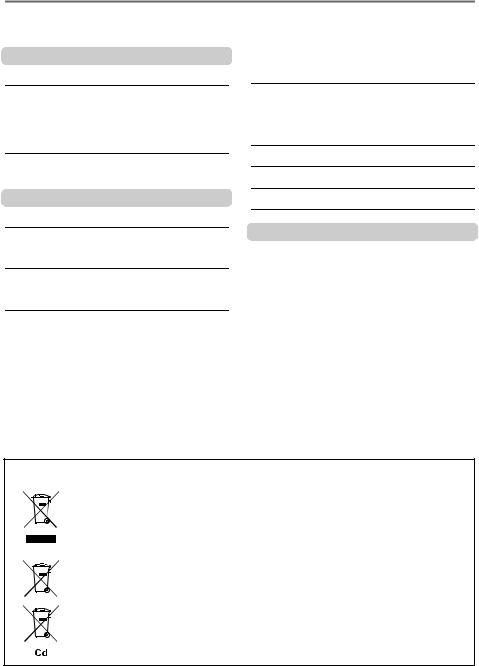
Contents
About the Manuals........................................................ |
8 |
Included Accessories.................................................... |
8 |
Setting Up |
|
Setting Up |
10 |
Try the Quiz - and Guess the Sound! |
19 |
Recording Your Performance |
|
(Phrase Recording) |
19 |
|
|
Connecting to Other Devices |
20 |
Power Requirements .................................................. |
10 |
Turning the Power On................................................. |
11 |
Auto Power Off function.............................................. |
11 |
Using the Music Rest.................................................. |
11 |
Panel Controls and Terminals |
12 |
Display Items .............................................................. |
14 |
How to Select a Voice/Song/Style .............................. |
14 |
Reference |
|
Playing the Keyboard |
15 |
Playing a Variety of Instrument Voices ....................... |
15 |
Playing the Keyboard with Two Persons (Duo mode)..... |
15 |
Playing and Practice Songs |
16 |
Playing Songs............................................................. |
16 |
Using the Song Lesson Feature ................................. |
16 |
Playing Rhythm and Accompaniment (Style) |
17 |
How to Play Chords when Playing the Style |
|
(Fingering Type)...................................................... |
18 |
Playing an External Audio Devices, such as a |
|
Smartphone, with the Built-in Speakers.................. |
20 |
Connecting Headphones or External Speakers ......... |
20 |
Using a Pedal (Sustain).............................................. |
20 |
The Functions |
21 |
Troubleshooting |
24 |
Specifications |
24 |
Index |
25 |
Appendix |
|
Voice List............................................................. |
26 |
SFX Kit List ......................................................... |
29 |
Style List.............................................................. |
30 |
Song List ............................................................. |
31 |
Effect Type List................................................... |
32 |
Smart Chord Chart ............................................. |
33 |
Information for users on collection and disposal of old equipment and used batteries:
These symbols on the products, packaging, and/or accompanying documents mean that used electrical and electronic products and batteries should not be mixed with general household waste.
For proper treatment, recovery and recycling of old products and used batteries, please take them to applicable collection points, in accordance with your national legislation.
By disposing of these products and batteries correctly, you will help to save valuable resources and prevent any potential negative effects on human health and the environment which could otherwise arise from inappropriate waste handling.
For more information about collection and recycling of old products and batteries, please contact your local municipality, your waste disposal service or the point of sale where you purchased the items.
For business users in the European Union:
If you wish to discard electrical and electronic equipment, please contact your dealer or supplier for further information.
Information on Disposal in other Countries outside the European Union:
These symbols are only valid in the European Union. If you wish to discard these items, please contact your local authorities or dealer and ask for the correct method of disposal.
Note for the battery symbol (bottom two symbol examples):
This symbol might be used in combination with a chemical symbol. In this case it complies with the requirement set by the EU Battery Directive for the chemical involved.
(weee_battery_eu_en_02)
PSR-E273 YPT-270 Owner’s Manual 9
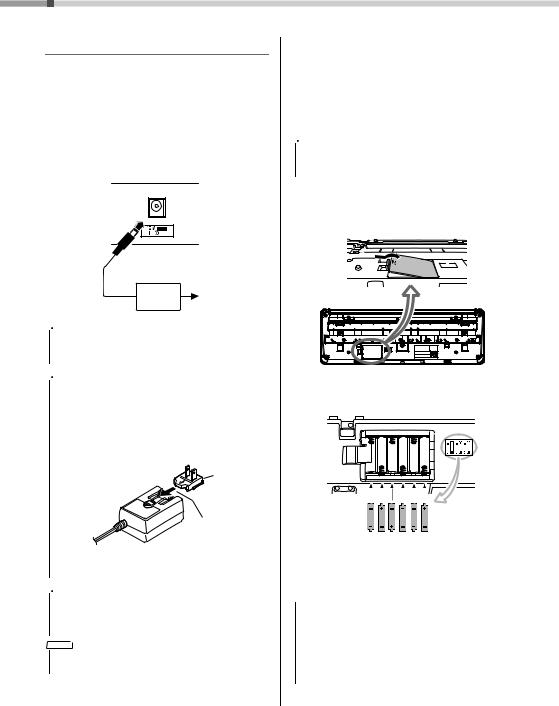
Setting Up
Power Requirements
Although the instrument will run either from an AC adaptor or batteries, Yamaha recommends use of an AC adaptor whenever possible. An AC adaptor is more environmentally friendly than batteries and does not deplete resources.
Using an AC Adaptor
Connect the AC adaptor in the order shown in the illustration.
DC IN jack (page 13)
1
AC |
2 |
|
AC outlet |
||
adaptor |
||
|
 WARNING
WARNING
•Use the specified AC adaptor (page 24) only. Using the wrong AC adaptor can result in damage to the instrument or overheating.
 WARNING
WARNING
•When using the AC adaptor with a removable plug, make sure to keep the plug attached to the AC adaptor. Using the plug alone can cause electric shock or fire.
•If the plug is accidentally removed from the AC adaptor, slide it back in until it clicks into place, taking care to avoid touching any internal metal parts. To avoid electric shock, short circuit or damage, also be careful that there is no dust between the AC adaptor and plug.
Plug |
Slide the plug as indicated.
The shape of the plug differs depending on your area.
 CAUTION
CAUTION
•When setting up the product, make sure that the AC outlet you are using is easily accessible. If some trouble or malfunction occurs, immediately turn the power off and disconnect the plug from the outlet.
NOTE
•Follow the order shown above in reverse when disconnecting the AC adaptor.
Using Batteries
This instrument requires six “AA” size, Alkaline (LR6)/ Manganese (R6) batteries, or rechargeable nickelmetal hydride batteries (rechargeable Ni-MH batteries). The Alkaline batteries or rechargeable Ni-MH batteries are recommended for this instrument, since other types may result in poorer battery performance.
 WARNING
WARNING
•When the batteries run out, or if the instrument is not to be used for a long time, remove the batteries from the instrument.
1 Make sure that the power of the instrument is off.
2Open the battery compartment cover located on the instrument’s bottom panel.
3Insert the six new batteries, being careful to follow the polarity markings on the inside of the compartment.
4Replace the compartment cover, making sure that it locks firmly in place.
Make sure to set the battery type correctly (page 11 ).
NOTICE
•Connecting or disconnecting the power adaptor with batteries installed may turn the power off, resulting in loss of data being recorded at the time.
•When battery power becomes too low for proper operation, the volume may be reduced, the sound may be distorted, and other problems may occur. When this happens, make sure to replace all batteries with new ones or already recharged ones.
10 PSR-E273 YPT-270 Owner’s Manual
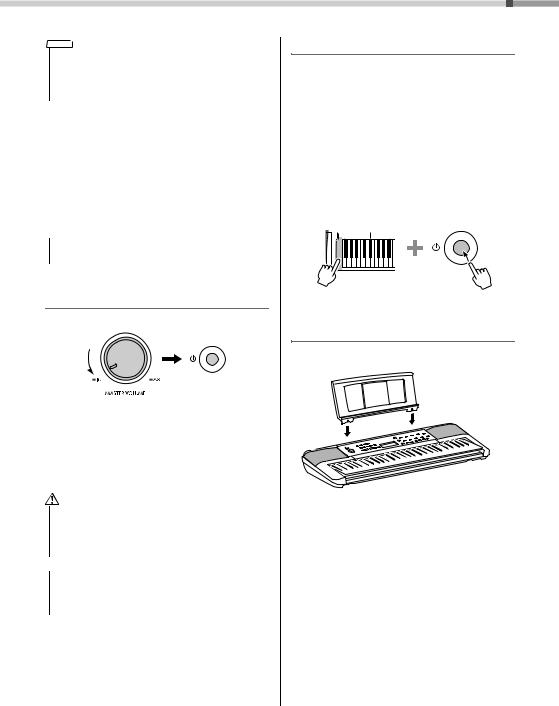
Setting Up
NOTE
•This instrument cannot charge the batteries. Use only the specified charger device when charging.
•Power will be automatically drawn from the AC adaptor if an AC adaptor is connected while batteries are installed in the instrument.
Setting the battery type
Depending on the battery type to be used, you may need to change the battery type setting on this instrument. Alkaline (and manganese) batteries are chosen by default. After installing new batteries and turning the power on, make sure to set the Battery Type appropriately (rechargeable or not) via Function number 027 (page 23).
NOTICE
•Failure to set the battery type may shorten the amount of the battery life. Make sure to set the battery type correctly.
Turning the Power On
1 Turn down the [MASTER VOLUME] dial to “MIN.”
2Press the [  ](Standby/On) switch to turn the power on. The Voice name appears on the display. Adjust the volume as desired while playing the keyboard.
](Standby/On) switch to turn the power on. The Voice name appears on the display. Adjust the volume as desired while playing the keyboard.
3Press and hold the [  ](Standby/On) switch for about a second to set the instrument to standby mode.
](Standby/On) switch for about a second to set the instrument to standby mode.
CAUTION
•Even when the [  ] (Standby/On) switch is in standby status, electricity is still flowing to the product at the minimum level. Remove the electric plug from the outlet when the instrument is not to be used for extended periods of time, or during electrical storms.
] (Standby/On) switch is in standby status, electricity is still flowing to the product at the minimum level. Remove the electric plug from the outlet when the instrument is not to be used for extended periods of time, or during electrical storms.
NOTICE
•Press only the [  ] (Standby/On) switch when turning the power on. Any other operations such as pressing the pedal are not allowed. Doing so may cause the instrument to malfunction.
] (Standby/On) switch when turning the power on. Any other operations such as pressing the pedal are not allowed. Doing so may cause the instrument to malfunction.
Auto Power Off function
To prevent unnecessary power consumption, this instrument features an Auto Power Off function that automatically turns the power off if the instrument is not operated for approximately 30 minutes by default; however, you can change this setting (Function Number 026; page 23).
To disable the Auto Power Off function:
Turn the power on while holding down the lowest key on the keyboard. A message “oFF AutoOff” appears briefly, then the instrument starts up with the Auto Power Off function disabled.
Using the Music Rest
Insert the music rest into the slots as shown.
PSR-E273 YPT-270 Owner’s Manual 11
